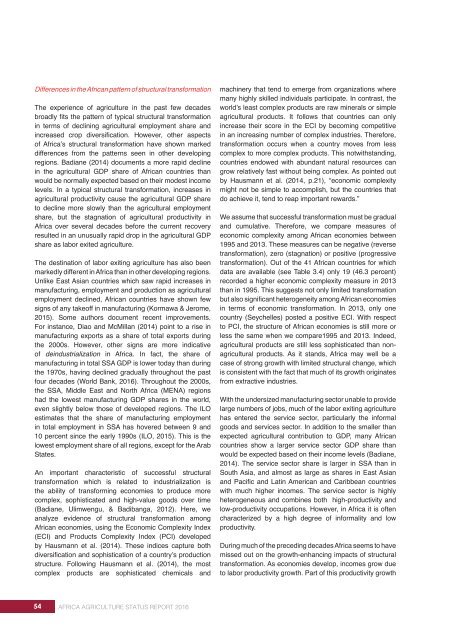AFRICA AGRICULTURE STATUS REPORT 2016
AASR-report_2016-1
AASR-report_2016-1
You also want an ePaper? Increase the reach of your titles
YUMPU automatically turns print PDFs into web optimized ePapers that Google loves.
Differences in the African pattern of structural transformation<br />
The experience of agriculture in the past few decades<br />
broadly fits the pattern of typical structural transformation<br />
in terms of declining agricultural employment share and<br />
increased crop diversification. However, other aspects<br />
of Africa’s structural transformation have shown marked<br />
differences from the patterns seen in other developing<br />
regions. Badiane (2014) documents a more rapid decline<br />
in the agricultural GDP share of African countries than<br />
would be normally expected based on their modest income<br />
levels. In a typical structural transformation, increases in<br />
agricultural productivity cause the agricultural GDP share<br />
to decline more slowly than the agricultural employment<br />
share, but the stagnation of agricultural productivity in<br />
Africa over several decades before the current recovery<br />
resulted in an unusually rapid drop in the agricultural GDP<br />
share as labor exited agriculture.<br />
The destination of labor exiting agriculture has also been<br />
markedly different in Africa than in other developing regions.<br />
Unlike East Asian countries which saw rapid increases in<br />
manufacturing, employment and production as agricultural<br />
employment declined, African countries have shown few<br />
signs of any takeoff in manufacturing (Kormawa & Jerome,<br />
2015). Some authors document recent improvements.<br />
For instance, Diao and McMillan (2014) point to a rise in<br />
manufacturing exports as a share of total exports during<br />
the 2000s. However, other signs are more indicative<br />
of deindustrialization in Africa. In fact, the share of<br />
manufacturing in total SSA GDP is lower today than during<br />
the 1970s, having declined gradually throughout the past<br />
four decades (World Bank, <strong>2016</strong>). Throughout the 2000s,<br />
the SSA, Middle East and North Africa (MENA) regions<br />
had the lowest manufacturing GDP shares in the world,<br />
even slightly below those of developed regions. The ILO<br />
estimates that the share of manufacturing employment<br />
in total employment in SSA has hovered between 9 and<br />
10 percent since the early 1990s (ILO, 2015). This is the<br />
lowest employment share of all regions, except for the Arab<br />
States.<br />
An important characteristic of successful structural<br />
transformation which is related to industrialization is<br />
the ability of transforming economies to produce more<br />
complex, sophisticated and high-value goods over time<br />
(Badiane, Ulimwengu, & Badibanga, 2012). Here, we<br />
analyze evidence of structural transformation among<br />
African economies, using the Economic Complexity Index<br />
(ECI) and Products Complexity Index (PCI) developed<br />
by Hausmann et al. (2014). These indices capture both<br />
diversification and sophistication of a country’s production<br />
structure. Following Hausmann et al. (2014), the most<br />
complex products are sophisticated chemicals and<br />
machinery that tend to emerge from organizations where<br />
many highly skilled individuals participate. In contrast, the<br />
world’s least complex products are raw minerals or simple<br />
agricultural products. It follows that countries can only<br />
increase their score in the ECI by becoming competitive<br />
in an increasing number of complex industries. Therefore,<br />
transformation occurs when a country moves from less<br />
complex to more complex products. This notwithstanding,<br />
countries endowed with abundant natural resources can<br />
grow relatively fast without being complex. As pointed out<br />
by Hausmann et al. (2014, p.21), “economic complexity<br />
might not be simple to accomplish, but the countries that<br />
do achieve it, tend to reap important rewards.”<br />
We assume that successful transformation must be gradual<br />
and cumulative. Therefore, we compare measures of<br />
economic complexity among African economies between<br />
1995 and 2013. These measures can be negative (reverse<br />
transformation), zero (stagnation) or positive (progressive<br />
transformation). Out of the 41 African countries for which<br />
data are available (see Table 3.4) only 19 (46.3 percent)<br />
recorded a higher economic complexity measure in 2013<br />
than in 1995. This suggests not only limited transformation<br />
but also significant heterogeneity among African economies<br />
in terms of economic transformation. In 2013, only one<br />
country (Seychelles) posted a positive ECI. With respect<br />
to PCI, the structure of African economies is still more or<br />
less the same when we compare1995 and 2013. Indeed,<br />
agricultural products are still less sophisticated than nonagricultural<br />
products. As it stands, Africa may well be a<br />
case of strong growth with limited structural change, which<br />
is consistent with the fact that much of its growth originates<br />
from extractive industries.<br />
With the undersized manufacturing sector unable to provide<br />
large numbers of jobs, much of the labor exiting agriculture<br />
has entered the service sector, particularly the informal<br />
goods and services sector. In addition to the smaller than<br />
expected agricultural contribution to GDP, many African<br />
countries show a larger service sector GDP share than<br />
would be expected based on their income levels (Badiane,<br />
2014). The service sector share is larger in SSA than in<br />
South Asia, and almost as large as shares in East Asian<br />
and Pacific and Latin American and Caribbean countries<br />
with much higher incomes. The service sector is highly<br />
heterogeneous and combines both high-productivity and<br />
low-productivity occupations. However, in Africa it is often<br />
characterized by a high degree of informality and low<br />
productivity.<br />
During much of the preceding decades Africa seems to have<br />
missed out on the growth-enhancing impacts of structural<br />
transformation. As economies develop, incomes grow due<br />
to labor productivity growth. Part of this productivity growth<br />
54 <strong>AFRICA</strong> <strong>AGRICULTURE</strong> <strong>STATUS</strong> <strong>REPORT</strong> <strong>2016</strong>


